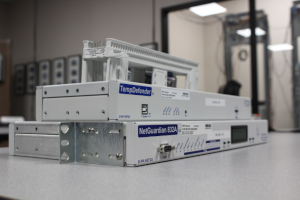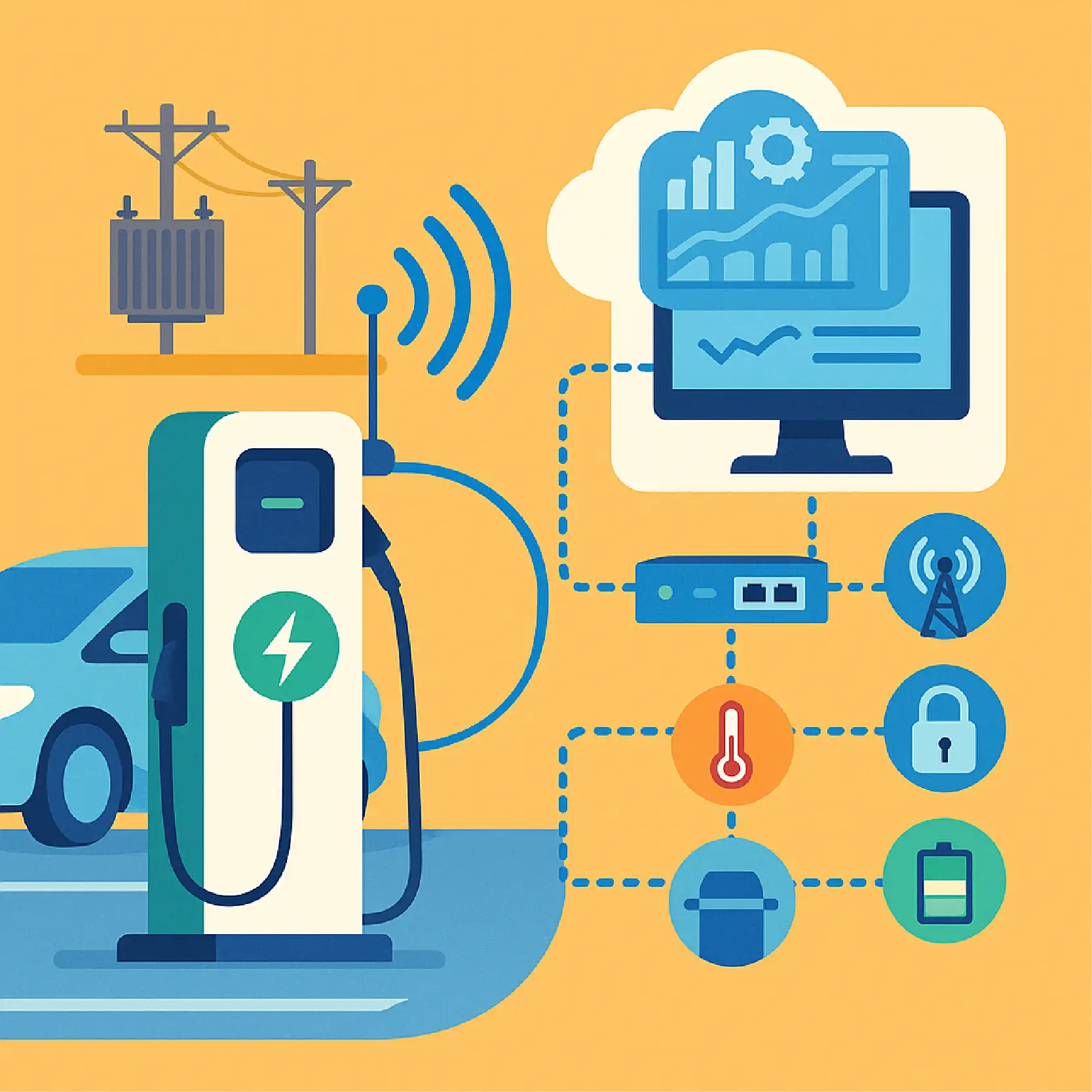Check out our White Paper Series!
A complete library of helpful advice and survival guides for every aspect of system monitoring and control.
1-800-693-0351
Have a specific question? Ask our team of expert engineers and get a specific answer!
Sign up for the next DPS Factory Training!

Whether you're new to our equipment or you've used it for years, DPS factory training is the best way to get more from your monitoring.
Reserve Your Seat TodayElectric vehicles (EVs) aren't just "the future." They're already here in a big way. Municipal fleets are electrifying, corporations are installing chargers for employees, and private industries are racing to meet surging consumer demand.
Yet, installing chargers is only half the story. Keeping these chargers online, efficient, and secure is a significant challenge - one that often goes unnoticed until a big outage or a hefty utility bill arrives. That's why SCADA (Supervisory Control and Data Acquisition) systems and reliable remote monitoring gear (for telecom equipment) are needed for their success.
In the next few minutes, you'll learn:
Let's begin!

When people think of EV charging, they picture a standalone pedestal in a parking lot. However, real EV charging infrastructure includes:
If any of these components fail - even if the charger hardware itself is fine - your site can go offline. That's why full visibility is so important.
Related Articles
Are you new to the SCADA world? If you need to deploy a new SCADA system, then you need to fully understand how to apply its monitoring and control capabilities to your specific scenario. Learn how to use a SCADA system.
by Morgana Siggins on December 4, 2019
The uptime for any kind of system won't be always at 100%. So, it's critical to know how to troubleshoot your SCADA system. Learn some ways to locate and solve your SCADA system problems.
by Morgana Siggins on July 22, 2020
A Supervisory Control and Data Acquisition system, also known as SCADA system, allows you to remotely manage your systems and overall operations. SCADA systems are complex - and they really have to be. The operation that...
by Andrew Erickson on March 18, 2019
SCADA is an architecture for supervising and controlling industrial systems. In EV charging:
SCADA acts as a centralized "control tower," making sure you don't have to wait for complaints to realize there's an issue.
A complement to SCADA here (and the terms are often used interchangeably) is "remote site monitoring" of telecom equipment. That usually involves monitoring the infrastructure that carries SCADA commands between you and your equipment.
For simplicity, I'm occasionally just going to use the term "SCADA" here to cover the entire remote monitoring/control system. When needed for clarity, I'll use more specific wording.
Having a SCADA system for EV charging means your system has:
Without SCADA, a charger might go down at 2 A.M., and you won't know until a customer reports or complains about it. SCADA provides continuous visibility, so you can respond immediately.
When you get an alarm that says "Site Offline," SCADA makes remote troubleshooting possible. You'll know whether it's the charger itself or supporting gear. This saves time and cuts down on site visits.
Large sites and DC fast chargers can place a big strain on local utilities. SCADA lets you anticipate surges, shift loads, and avoid utility penalties.
Managing a few chargers is simple, but managing hundreds isn't as easy. SCADA helps you unify monitoring, apply updates remotely, and maintain consistent reporting.
A SCADA system's usefulness depends on the quality of data inputs it receives. If your SCADA only checks charger status, it won't tell you why a site is down. Is it a tripped breaker? A fan failure in the battery backup? A network outage?
That's where remote telemetry solutions come in. By monitoring the full site, you can see the actual cause of downtime so you can resolve it as fast as possible.
At DPS Telecom, we specialize in remote site monitoring (and general SCADA equipment, except for very specific & massive production/treatment/manufacturing facilities). We don't build chargers or SCADA platforms. We provide the critical site-level data those systems need. Our NetGuardian Remote Telemetry Units (RTUs) keep tabs on:
NetGuardian RTUs support open protocols like SNMP (v1-v3) and MODBUS. You can also get email or SMS notifications. Whether you have an existing SCADA system, or are building one, these RTUs integrate without forcing a full system overhaul.
EV chargers often live in tough environments (extreme heat, cold, or humidity). Our devices are temperature-hardened, DIN-rail or rack-mountable, and available with backup power options.
An EV charging network is more than a collection of pedestals. It's an integrated system that needs:
Together, they offer:
As more EVs hit the road, charging sites are placing unprecedented demands on local utilities. DC fast chargers can draw massive current in short bursts (at peak times of the day), creating peak loads that can trigger:
By monitoring switchgear, rectifiers, and power flow with NetGuardian RTUs, you can spread out loads, schedule charge sessions, or switch to battery backups when usage spikes.
Many EV projects start with a handful of chargers. Over time, you're managing dozens, then hundreds of geographically dispersed sites. Without remote monitoring, you'll waste too much time and money on:
That's why a reputable RTU becomes non-negotiable at scale. NetGuardian RTUs help you keep a close watch, no matter how many sites come online.
A common fear is that new monitoring gear will force you to replace existing management software or charger platforms. The good news is NetGuardian RTUs aren't vendor-specific. With standard protocols - SNMP, MODBUS, DNP3, etc. - it fits into most SCADA or charger management systems. Whether you use ChargePoint, ABB, Siemens, or a homegrown solution, you won't need to ditch your current setup.
EV chargers endure rain, snow, heat waves, dusty highways, and other significant environmental conditions. Monitoring gear that fails first isn't going to be helpful. Choose devices, like NetGuardians, that are equipment to handle harsh environments. You'll want equipment that has:
A good practice is to choose a manufacturer that offers a support team available to troubleshoot issues quickly (if they ever arise). The stronger the reputation of the gear, the better.
Consider the ripple effects of a charging outage. You may have to face:
Over time, these costs will add up. Proactive remote monitoring often pays for itself by preventing just a few major outages. With real-time alarms and remote diagnostics, you can fix problems before they become an expensive crisis.
EV chargers are digital endpoints, just like any other network-capable gear. This makes them potential cyber targets. They're also physical objects that can be vandalized. With NetGuardian RTUs, you'll be able to:
Security is much more than digital firewalls. It's also physical site protection. A compromised charging station can erode public trust and risk broader network breaches.
If you're deploying or expanding EV charging, don't overlook the infrastructure that powers and protects those chargers. By adding NetGuardian RTUs - and other reliable monitoring gear - to your SCADA system, you'll:
DPS Telecom has decades of experience helping utilities, telecoms, and public agencies build reliable monitoring solutions. We'll integrate with your existing platforms, or supply a complete system if you're just getting started.
Together, we'll design a solution to keep your chargers (and your business) fully charged and ready for the road ahead.

Andrew Erickson
Andrew Erickson is an Application Engineer at DPS Telecom, a manufacturer of semi-custom remote alarm monitoring systems based in Fresno, California. Andrew brings more than 19 years of experience building site monitoring solutions, developing intuitive user interfaces and documentation, and opt...